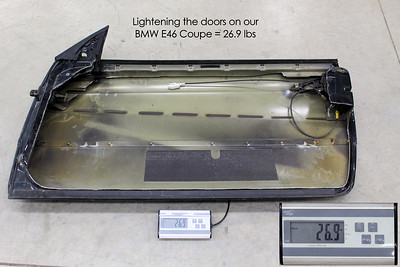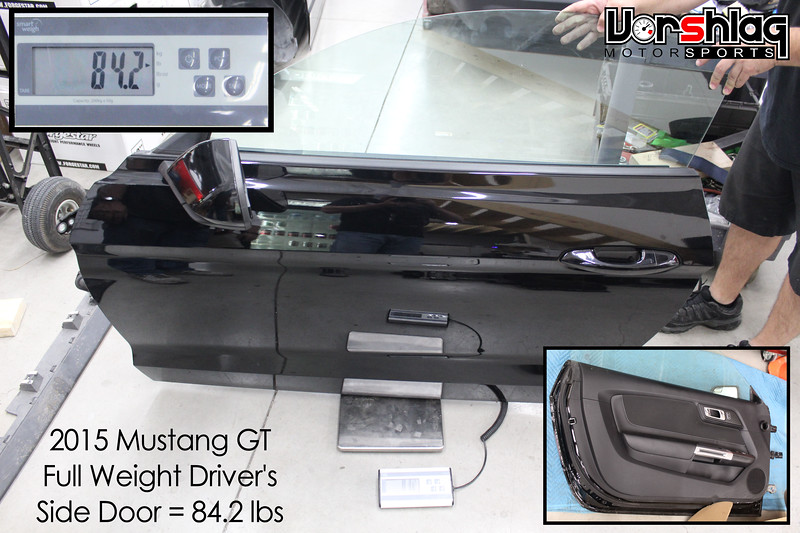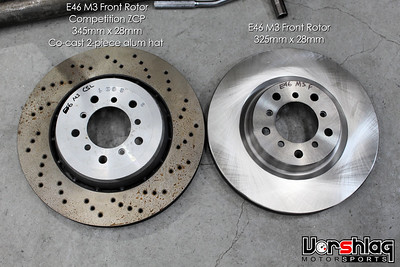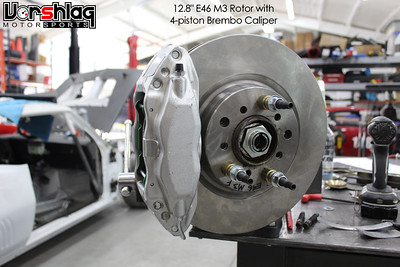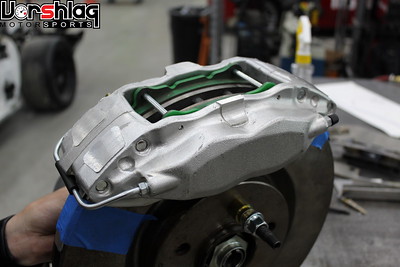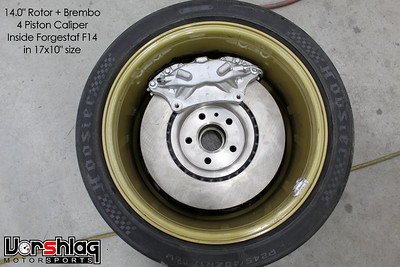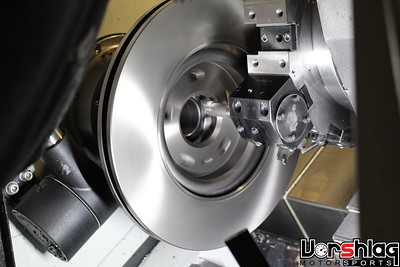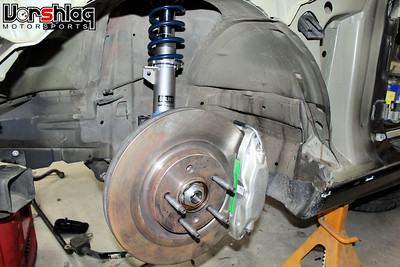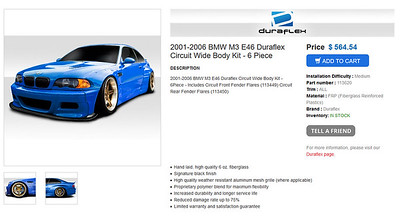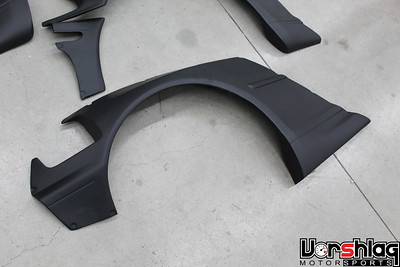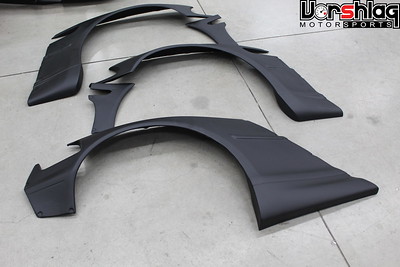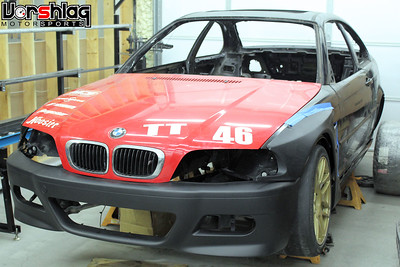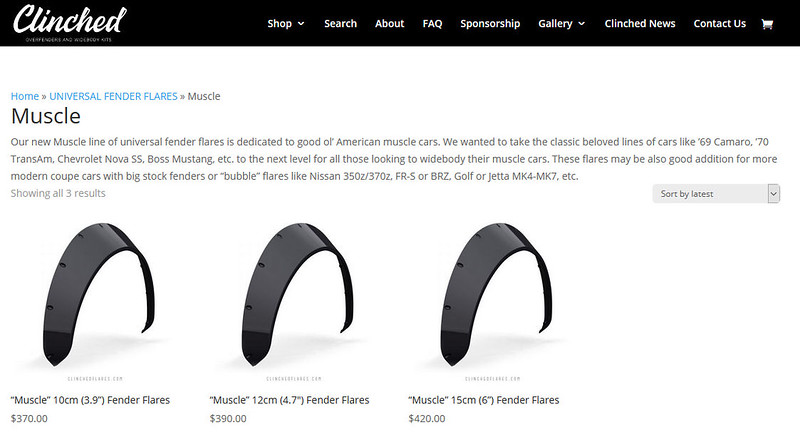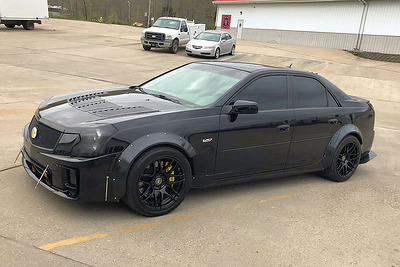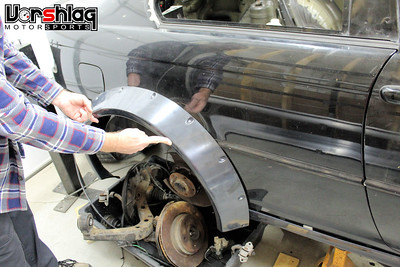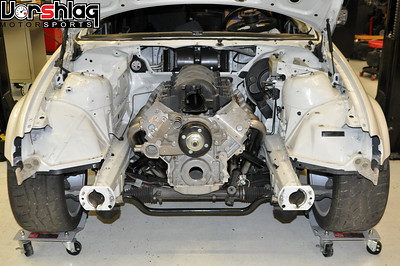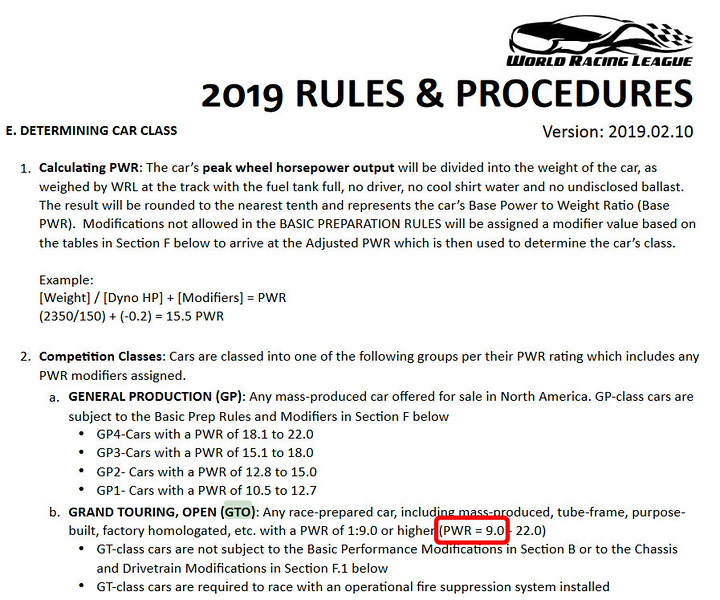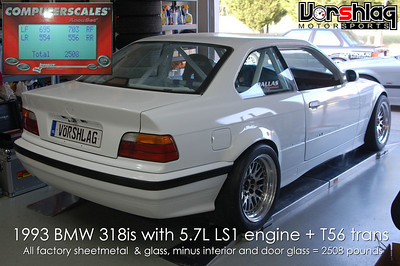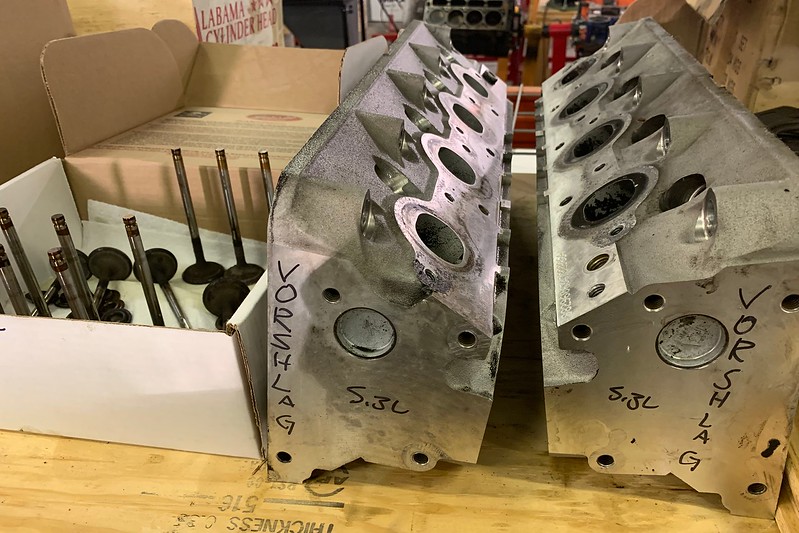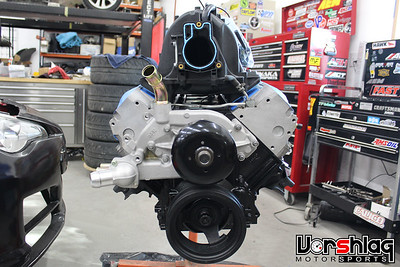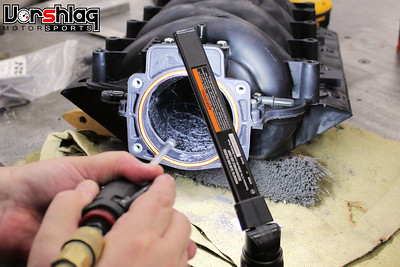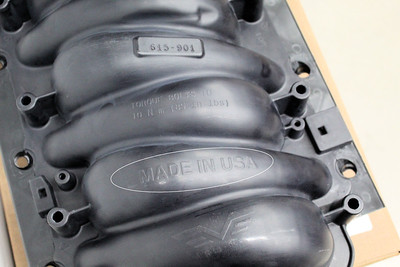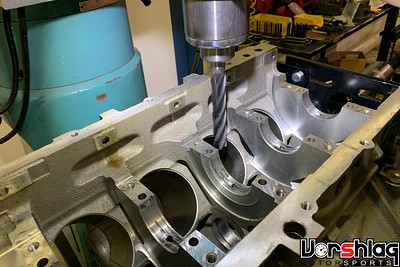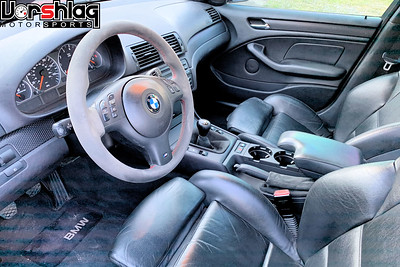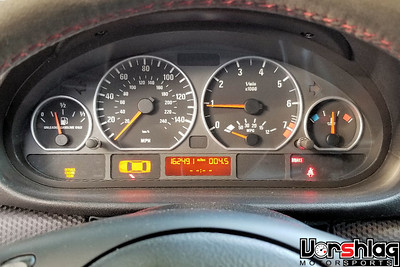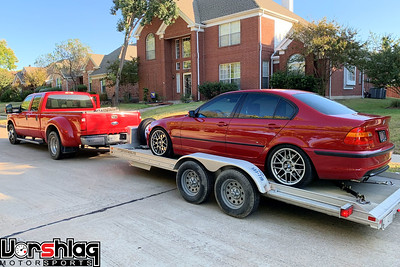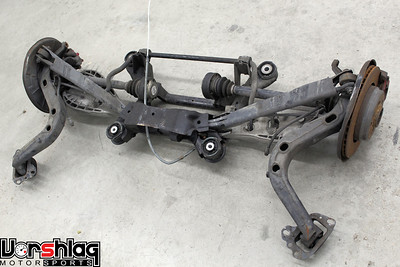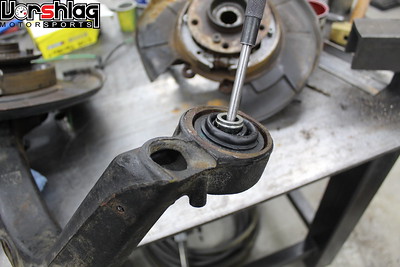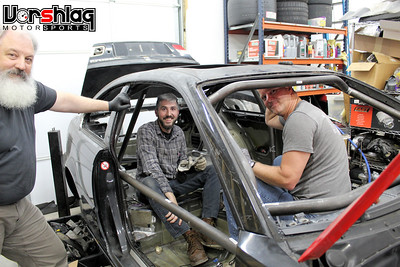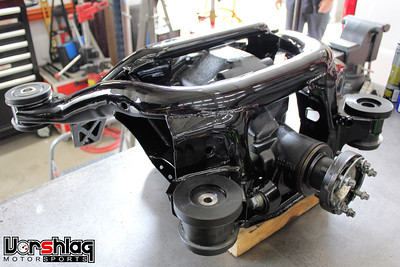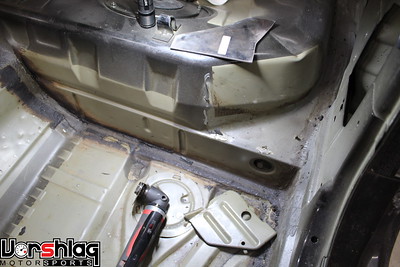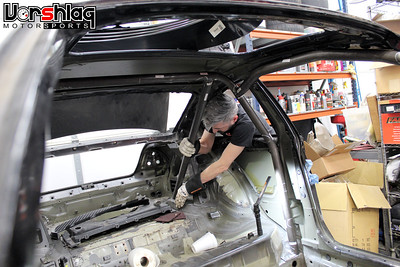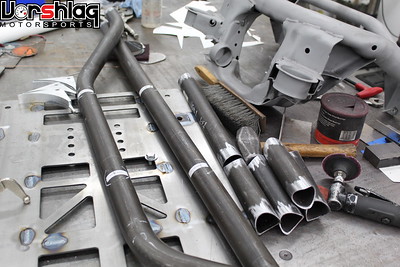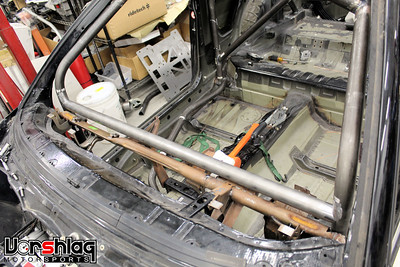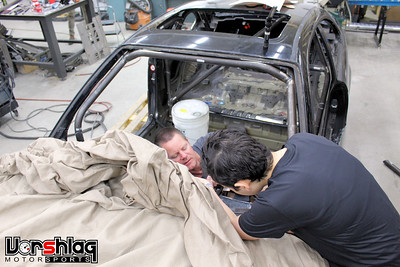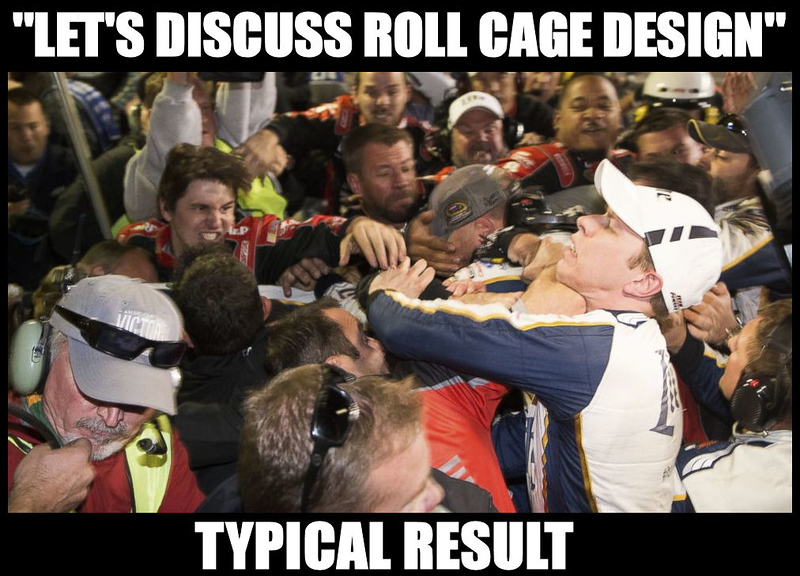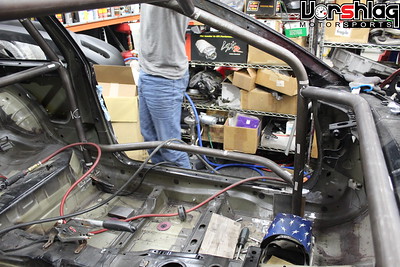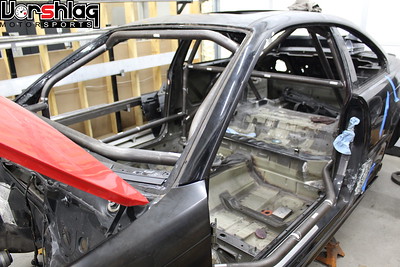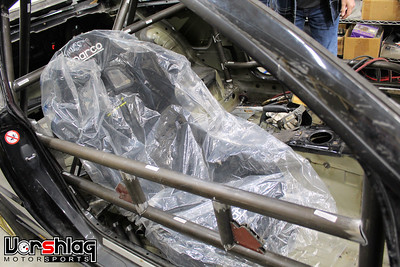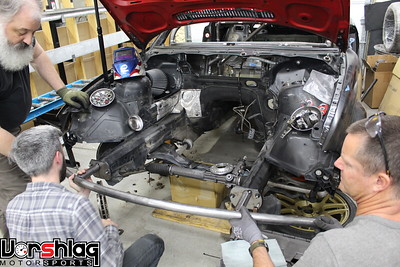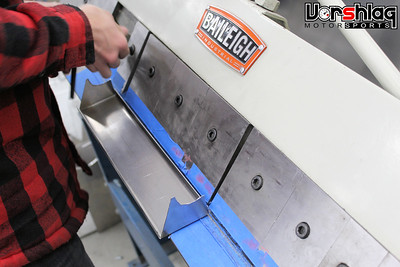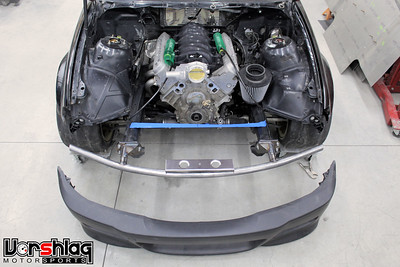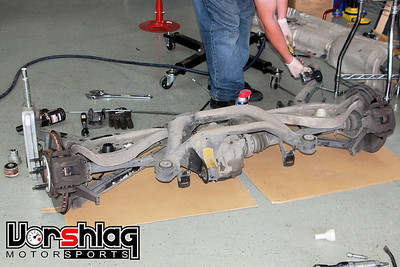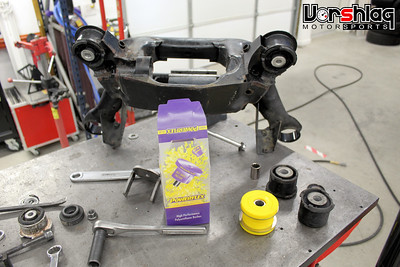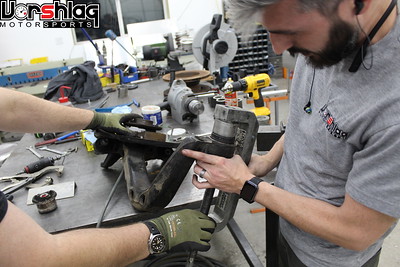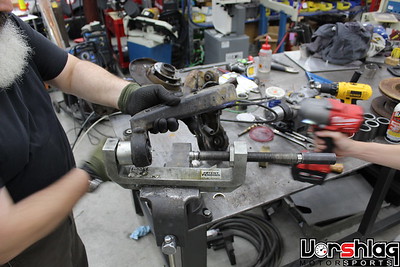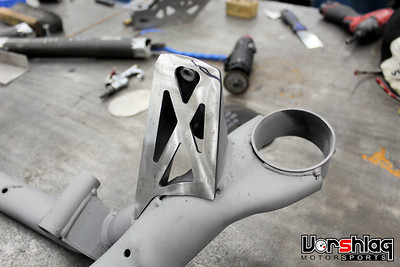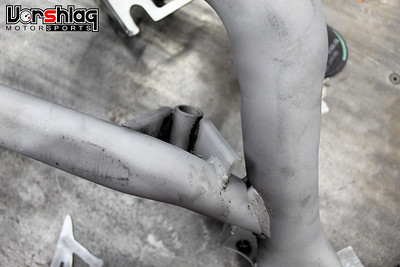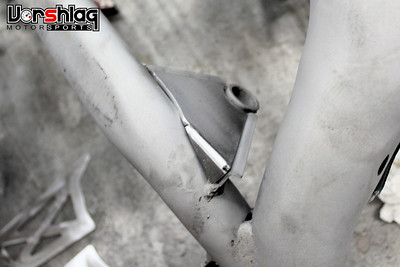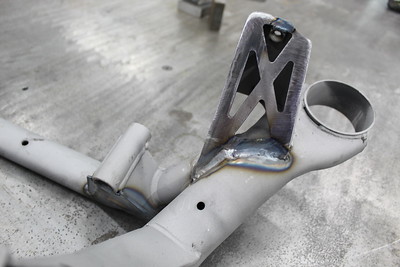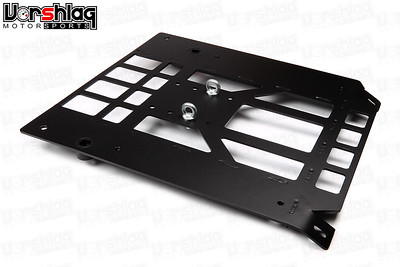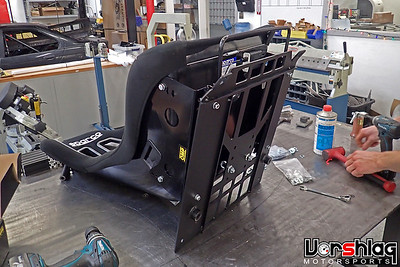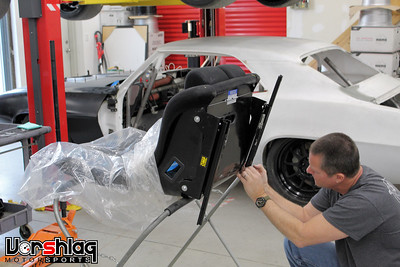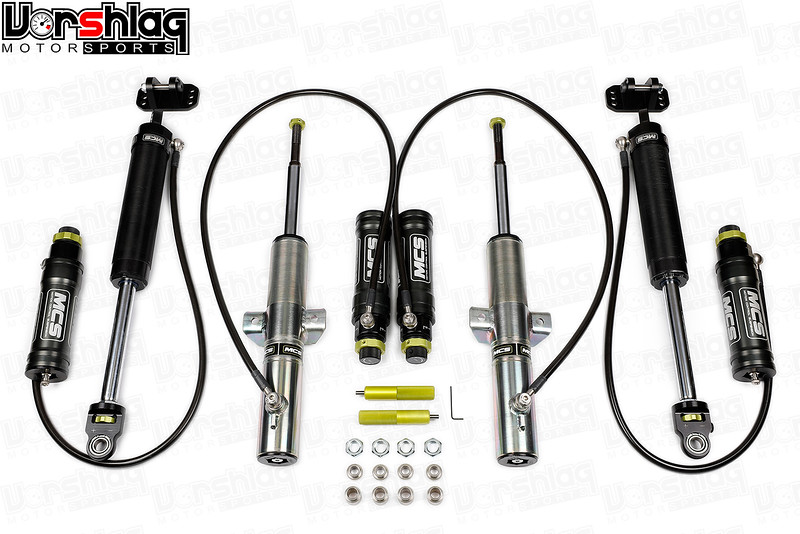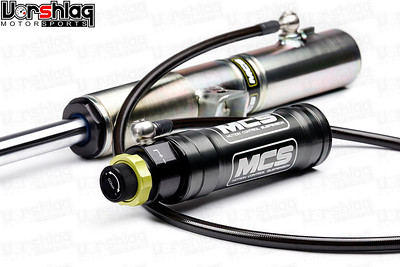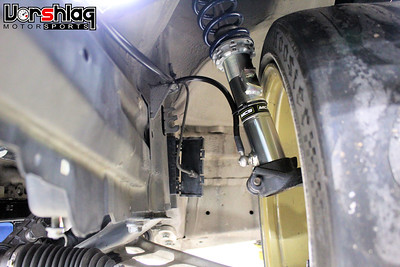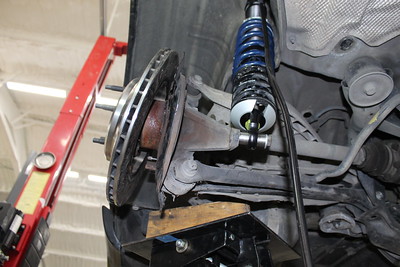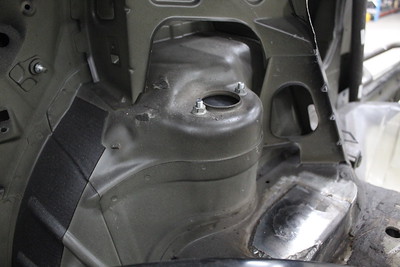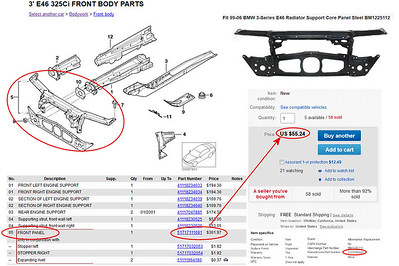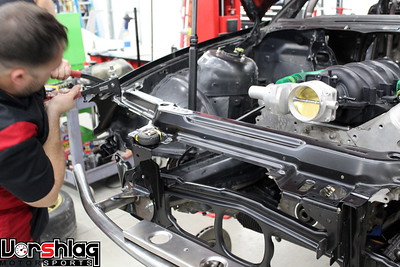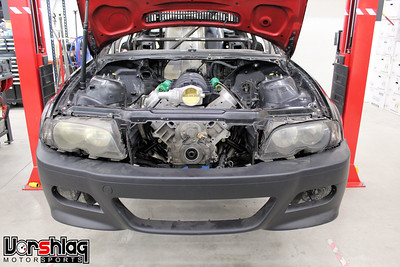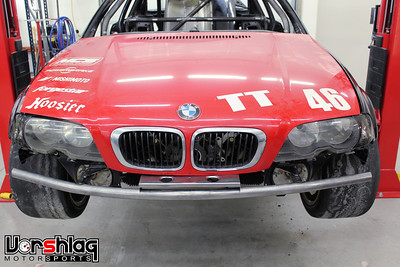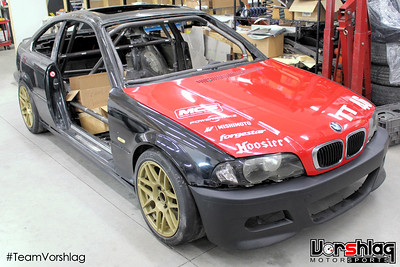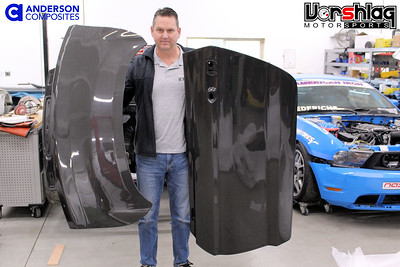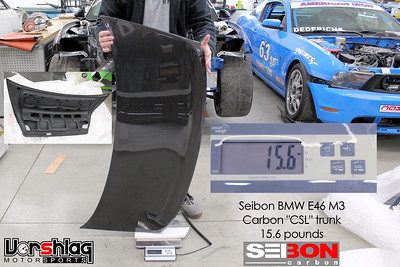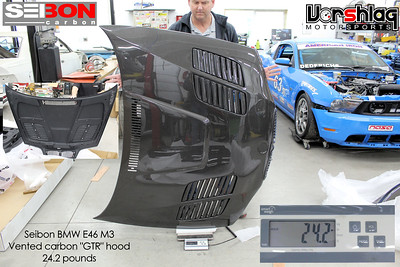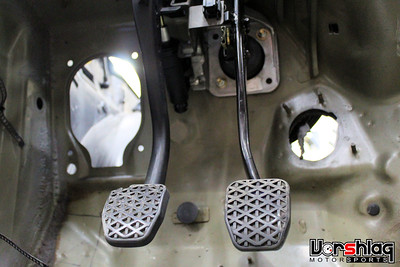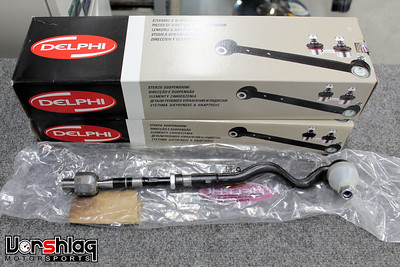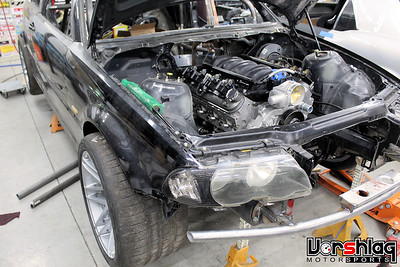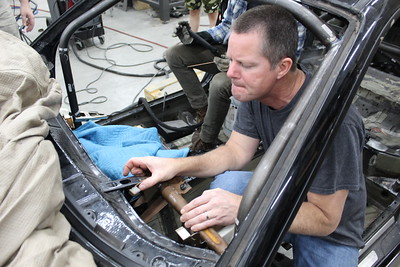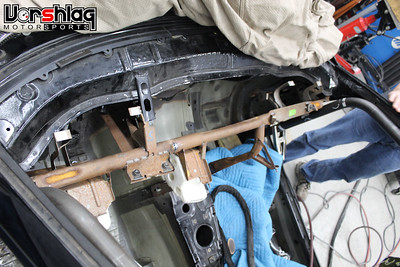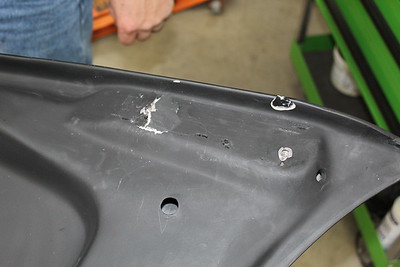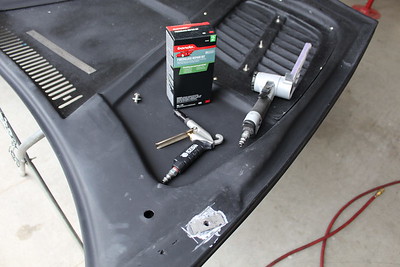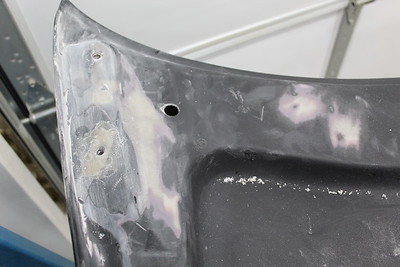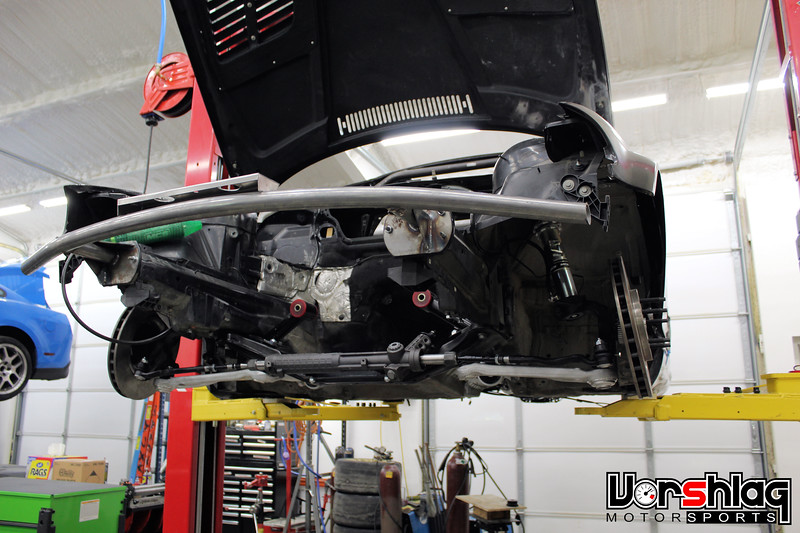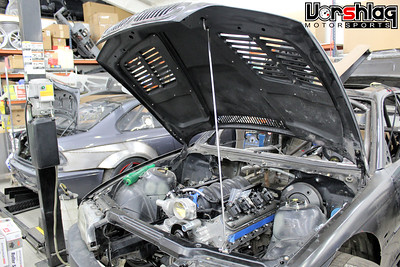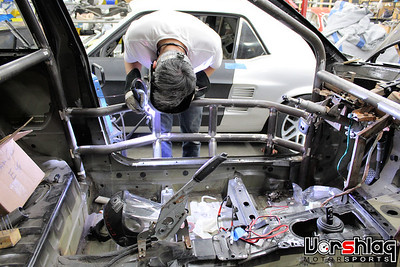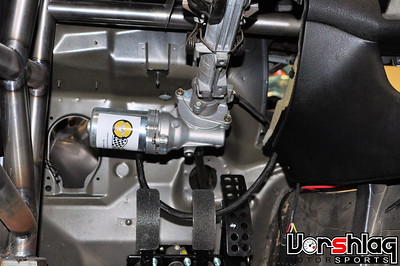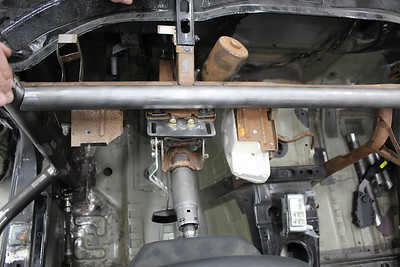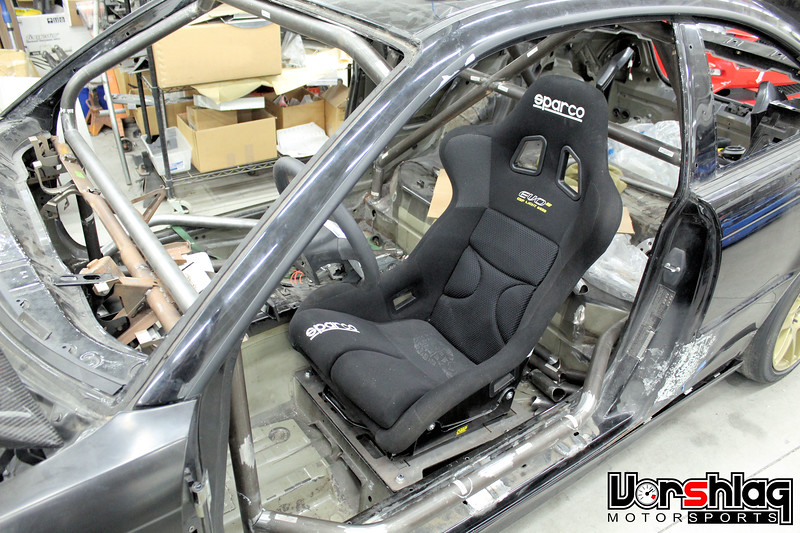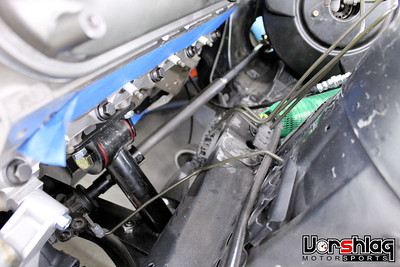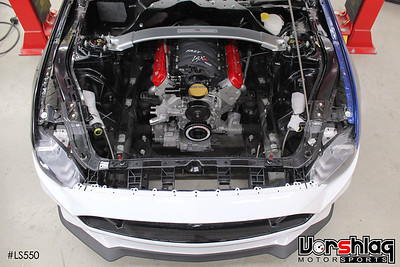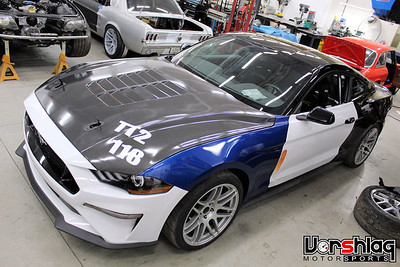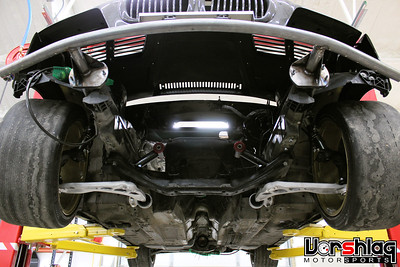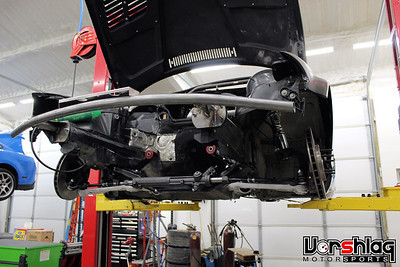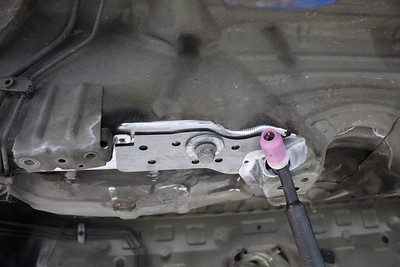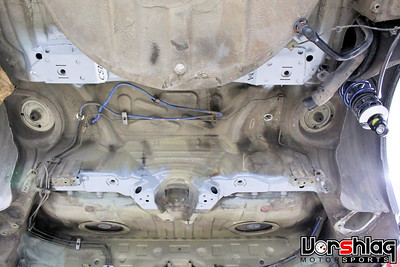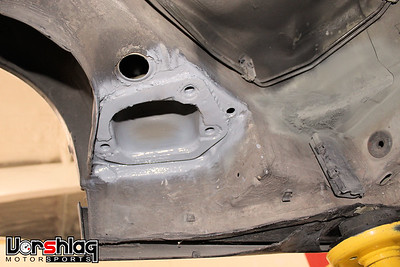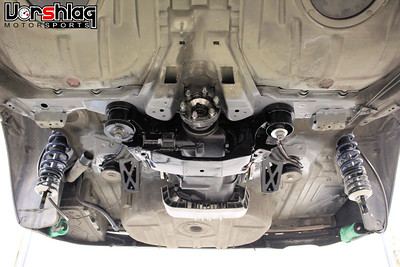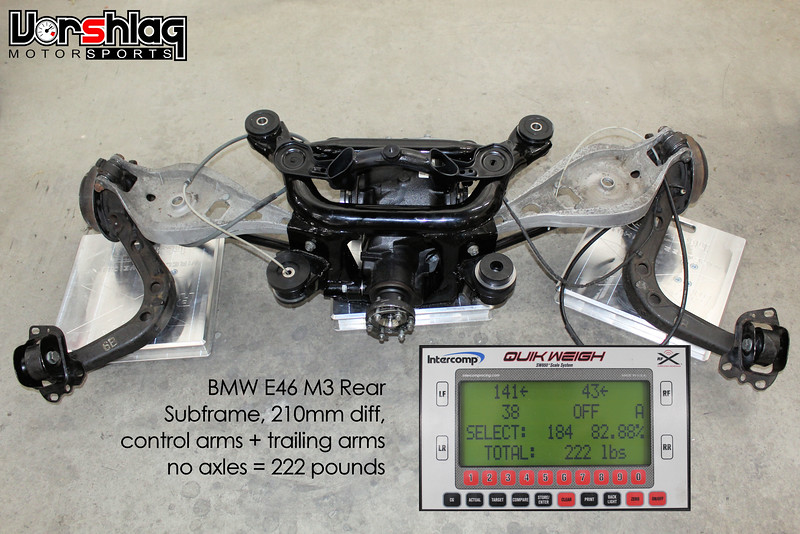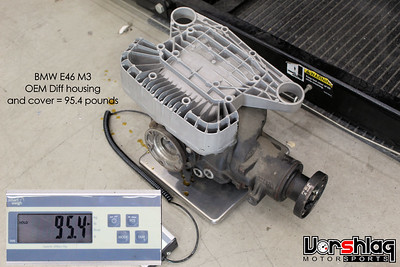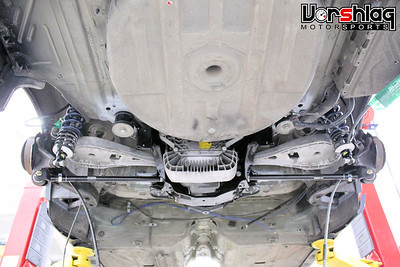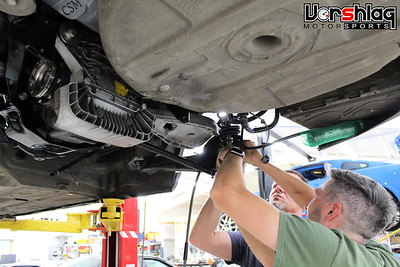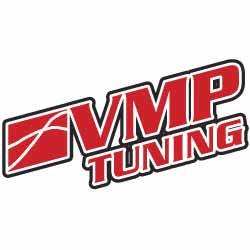continued from above
REPLACING A FRONT FENDER
This should be an easy one, but I re-learned a lesson here. The left front fender was smashed when we got this rolling chassis for a song - not a big deal, as I keep a couple of pairs of front E46 steel fenders in stock to use for metal flare jobs on E36 chassis (for before - when there were not good flare options). But it had been a number of years since I had bought these fenders...
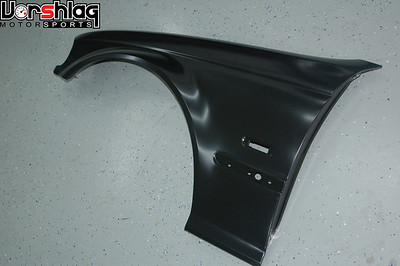

Again, we haven't done a steel E36 flare job like this in years - because there are so many good flares and widebody options for the E36 now. The E46 is no different, as I will show below. But I had forgotten that we utilized E46 non-M SEDAN front fenders for our E36 flare jobs. It came down to the recessed trim section in the sedan fenders was further back and "out of the flare" section. That made the welded steel flare jobs on E36 cars easier. We would cut out the fender flare portion of these E46 fenders then graft them to the E36 (see above right). It was a bunch of work but could turn out nice with a little bodywork and paint.


So when the smashed coupe fender was removed, I grabbed one of these SEDAN fenders, not remembering it wasn't a COUPE front fender. It was on the car for a couple of months - because with the front nose and left side door off it wasn't obvious it was the wrong one. If you look at this fender installed, above right, you will notice the body lines from the A-pillar don't match up - that's all that was visible... So when we test fit the Extreme Dimensions flares (shown further below) it "didn't fit".
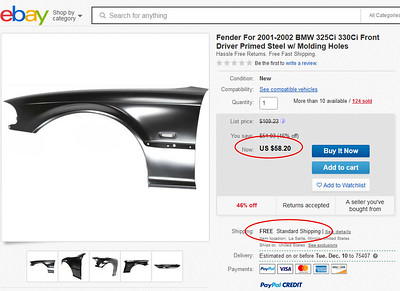

Again - a weird mistake, and it would have been immediately evident if the door was installed. Luckily replacement coupe fenders are still cheap for these cars and I found some for $58 shipped. I used to pay closer to $33 for these import fenders from a local Certifit store, but that's a 3 hour round trip in traffic to save maybe $20. This is one of the few things eBay is good for - cheap used parts or import body parts. Probably won't be the last fender we will need on an endurance car, hehe.
MOUNTING THE NOSE + TUBULAR BUMPER BEAM
We aren't 100% done with this step but I will show some progress. The "M3 style" front bumper cover is an import unit designed for use on a Non-M coupe chassis. This is often used by Spec E46 users, and we will utilize this item for the better grill openings and flatter bottom - which makes adding a splitter easier.


At this point we have the bumper cover mocked up - we needed that for the flare fitment tests. The factory plastic brackets at the tub are holding the receiving "cups" on the bumper cover, with the weight held up by a bucket for now. The cover needs a bumper beam to mount to, with brackets to hold it in place. We plan to have a rolled radiator that is feeding the radiator from the lower grill opening only. to make room for that a tubular bumper beam is a trick we often use to make more room. Here's an example of what we have planned, which we built this year for my wife's LS swapped 86...
TUBULAR BUMPER BEAM ON 86
We almost always start with our tubing roller (below left), install the appropriate dies, and then pick a piece of 1.50 x .095" wall, 1.75" x .095" wall or 1.75 x .120" wall seamless DOM tubing. We cut this to length and then bend the main curve to match the bumper cover.


On this car we were using a carbon fiber aftermarket nose, which had both a curve and needed two bends to kick in for the portions outside of the radiator. Some folks will stop their tubular bash bar at the frame rails, like most OEM beams do. We have seen car-to-car contact rip bumper covers off, destroy headlights, and more. With our full width bumper beams on other cars we have seen our customers "come out on top" of any contact.


Above left you can see how closely this tubular bumper beam matches the shape of the nose we are using - again, necessitating a couple of bends to kick in outside of the frame rails and under the headlights. This FULL WIDTH beam is much stronger and protective than the "half bumpers" we see some build. The mounting plates are cut on our CNC plasma table then the bar is mocked up underneath the bumper cover to figure out the lengths for the tubing mounts. These are fish mouthed and added to the mounting plates and beam. It is all tacked up on the car but finish TIG welded on the fab bench, above right.
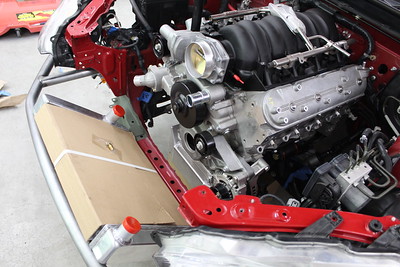

These pictures above show the rolled radiator - its also only fed from the lower grill opening, and mounted way forward and down. This makes venting the hood much more effective, and we will do the same thing on our E46. The upper and lower radiator mounts will be custom made, of course. We may or may not make a duct box to the hood opening behind the radiator, but we will definitely make the lower grill opening ducted to the front side of the radiator and oil cooler.

This is as far as we've gotten. On our next weekly work night we should have this tubular beam welded to the mounting plates at the frame stubs, visible behind the bumper in the pic above. Then we will add twin tow hooks to the font, some simple brackets from the tube to the bumper cover, spec the radiator, and build brackets for the radiator and oil cooler. Much more on this task next time.
FRONT SUSPENSION MOCK-UP
We bought this car on very worn OEM struts, springs and "mushroomed" top mounts. After some initial work on one of our 2-post lifts this car was moved to a back corner of the shop for the next phase of work, and the OEM struts were tossed. They were total junk. We needed wheels on the car to test fit the fender flares and for our design work on the Brembo BBK, but the OEM stuff was so long that the ride heights would be totally wack.


Luckily we had an extra Ohlins E46 coilover strut so we found a coilover spring, added a Vorshlag camber plate, and mounted that to the left front. This is not likely our final suspension but close enough for mock-up testing.


One small downside to inverted struts is the spring and body lengths make it harder to fit "the spring above the tire", which limits how far inboard the wheel can fit. Not an issue with most wheel setups on these cars but "We're going to eleven". We need ALL of that room and more. We mounted one of my E46 17x10" Forgestar wheels and 10.2" wide Hoosiers for the next steps.
continued below
REPLACING A FRONT FENDER
This should be an easy one, but I re-learned a lesson here. The left front fender was smashed when we got this rolling chassis for a song - not a big deal, as I keep a couple of pairs of front E46 steel fenders in stock to use for metal flare jobs on E36 chassis (for before - when there were not good flare options). But it had been a number of years since I had bought these fenders...


Again, we haven't done a steel E36 flare job like this in years - because there are so many good flares and widebody options for the E36 now. The E46 is no different, as I will show below. But I had forgotten that we utilized E46 non-M SEDAN front fenders for our E36 flare jobs. It came down to the recessed trim section in the sedan fenders was further back and "out of the flare" section. That made the welded steel flare jobs on E36 cars easier. We would cut out the fender flare portion of these E46 fenders then graft them to the E36 (see above right). It was a bunch of work but could turn out nice with a little bodywork and paint.


So when the smashed coupe fender was removed, I grabbed one of these SEDAN fenders, not remembering it wasn't a COUPE front fender. It was on the car for a couple of months - because with the front nose and left side door off it wasn't obvious it was the wrong one. If you look at this fender installed, above right, you will notice the body lines from the A-pillar don't match up - that's all that was visible... So when we test fit the Extreme Dimensions flares (shown further below) it "didn't fit".


Again - a weird mistake, and it would have been immediately evident if the door was installed. Luckily replacement coupe fenders are still cheap for these cars and I found some for $58 shipped. I used to pay closer to $33 for these import fenders from a local Certifit store, but that's a 3 hour round trip in traffic to save maybe $20. This is one of the few things eBay is good for - cheap used parts or import body parts. Probably won't be the last fender we will need on an endurance car, hehe.
MOUNTING THE NOSE + TUBULAR BUMPER BEAM
We aren't 100% done with this step but I will show some progress. The "M3 style" front bumper cover is an import unit designed for use on a Non-M coupe chassis. This is often used by Spec E46 users, and we will utilize this item for the better grill openings and flatter bottom - which makes adding a splitter easier.


At this point we have the bumper cover mocked up - we needed that for the flare fitment tests. The factory plastic brackets at the tub are holding the receiving "cups" on the bumper cover, with the weight held up by a bucket for now. The cover needs a bumper beam to mount to, with brackets to hold it in place. We plan to have a rolled radiator that is feeding the radiator from the lower grill opening only. to make room for that a tubular bumper beam is a trick we often use to make more room. Here's an example of what we have planned, which we built this year for my wife's LS swapped 86...
TUBULAR BUMPER BEAM ON 86
We almost always start with our tubing roller (below left), install the appropriate dies, and then pick a piece of 1.50 x .095" wall, 1.75" x .095" wall or 1.75 x .120" wall seamless DOM tubing. We cut this to length and then bend the main curve to match the bumper cover.


On this car we were using a carbon fiber aftermarket nose, which had both a curve and needed two bends to kick in for the portions outside of the radiator. Some folks will stop their tubular bash bar at the frame rails, like most OEM beams do. We have seen car-to-car contact rip bumper covers off, destroy headlights, and more. With our full width bumper beams on other cars we have seen our customers "come out on top" of any contact.


Above left you can see how closely this tubular bumper beam matches the shape of the nose we are using - again, necessitating a couple of bends to kick in outside of the frame rails and under the headlights. This FULL WIDTH beam is much stronger and protective than the "half bumpers" we see some build. The mounting plates are cut on our CNC plasma table then the bar is mocked up underneath the bumper cover to figure out the lengths for the tubing mounts. These are fish mouthed and added to the mounting plates and beam. It is all tacked up on the car but finish TIG welded on the fab bench, above right.


These pictures above show the rolled radiator - its also only fed from the lower grill opening, and mounted way forward and down. This makes venting the hood much more effective, and we will do the same thing on our E46. The upper and lower radiator mounts will be custom made, of course. We may or may not make a duct box to the hood opening behind the radiator, but we will definitely make the lower grill opening ducted to the front side of the radiator and oil cooler.

This is as far as we've gotten. On our next weekly work night we should have this tubular beam welded to the mounting plates at the frame stubs, visible behind the bumper in the pic above. Then we will add twin tow hooks to the font, some simple brackets from the tube to the bumper cover, spec the radiator, and build brackets for the radiator and oil cooler. Much more on this task next time.
FRONT SUSPENSION MOCK-UP
We bought this car on very worn OEM struts, springs and "mushroomed" top mounts. After some initial work on one of our 2-post lifts this car was moved to a back corner of the shop for the next phase of work, and the OEM struts were tossed. They were total junk. We needed wheels on the car to test fit the fender flares and for our design work on the Brembo BBK, but the OEM stuff was so long that the ride heights would be totally wack.


Luckily we had an extra Ohlins E46 coilover strut so we found a coilover spring, added a Vorshlag camber plate, and mounted that to the left front. This is not likely our final suspension but close enough for mock-up testing.


One small downside to inverted struts is the spring and body lengths make it harder to fit "the spring above the tire", which limits how far inboard the wheel can fit. Not an issue with most wheel setups on these cars but "We're going to eleven". We need ALL of that room and more. We mounted one of my E46 17x10" Forgestar wheels and 10.2" wide Hoosiers for the next steps.
continued below











